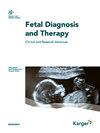在健康模型中经羊膜输送表面活性蛋白 B mRNA。
IF 1.6
3区 医学
Q3 OBSTETRICS & GYNECOLOGY
引用次数: 0
摘要
引言我们试图确定外源性表面活性蛋白B(SPB)mRNA是否能通过简单的羊膜腔注射被胎儿肺部吸收和翻译。方法12个不同时间段的母体的胎儿(n=149)在妊娠第17天(E17,足月=E21-22)接受羊膜腔内注射包裹在脂质多聚物中的人SPB(hSPB)mRNA(mRNA,n=99)或不含mRNA的脂质多聚物(对照;n=50)。每天用 ELISA 方法筛查肺部的 hSPB,直至足月。通过荧光测定法测量羊水中的磷脂酰胆碱(表面活性物质生成的替代物)。结果与对照组相比,mRNA 组在 E18(100% 对 85.7%)和 E20(100% 对 83.3%)时的存活率显著提高(均为 p<0.001)。如果用不含 mRNA 的注射进行对照,在 E18、19 和足月时,mRNA 组的肺中可检测到 hSPB 蛋白(p=0.002 至 <0.001)。与对照组相比,羊水磷脂酰胆碱水平在足月时有所增加[285.9 (251.1, 363.9)μM vs. 263.1 (222.8, 309.1)μM],但这并不显著(p=0.33)。经羊膜递送 mRNA 可成为围产期表面活性蛋白替代的一种新策略。本文章由计算机程序翻译,如有差异,请以英文原文为准。
Transamniotic Delivery of Surfactant Protein B mRNA in a Healthy Model.
INTRODUCTION
We sought to determine whether exogenous surfactant protein B (SPB) mRNA could be incorporated and translated by the fetal lung after simple transamniotic administration.
METHODS
Fetuses (n=149) of twelve time-dated dams underwent intra-amniotic injections of either human SPB (hSPB) mRNA encapsulated into lipopolyplex (mRNA, n=99), or of lipopolyplex without mRNA (control; n=50) on gestational day 17 (E17, term=E21-22). Lungs were screened for hSPB by ELISA daily until term. Phosphatidylcholine (a surrogate for surfactant production) was measured in the amniotic fluid by fluorometric assay. Statistical analysis included nonparametric Wilcoxon rank sum test.
RESULTS
Significantly improved survival in the mRNA group compared to controls was observed at E18 (100% vs. 85.7%) and E20 (100% vs. 83.3%) (both p<0.001). When controlled by mRNA-free injections, hSPB protein was detected in the mRNA group's lungs at E18, 19, and term (p=0.002 to <0.001). Amniotic fluid phosphatidylcholine levels were increased compared to control at term [285.9 (251.1, 363.9)μM vs. 263.1 (222.8, 309.1)μM], however this did not reach significance (p=0.33).
CONCLUSIONS
Encapsulated exogenous SPB mRNA can be incorporated and translated by fetal lung cells following intra-amniotic injection in a healthy rat model. Transamniotic mRNA delivery could become a novel strategy for perinatal surfactant protein replacement.
求助全文
通过发布文献求助,成功后即可免费获取论文全文。
去求助
来源期刊

Fetal Diagnosis and Therapy
医学-妇产科学
CiteScore
4.70
自引率
9.10%
发文量
48
审稿时长
6-12 weeks
期刊介绍:
The first journal to focus on the fetus as a patient, ''Fetal Diagnosis and Therapy'' provides a wide range of biomedical specialists with a single source of reports encompassing the common discipline of fetal medicine.
 求助内容:
求助内容: 应助结果提醒方式:
应助结果提醒方式:


